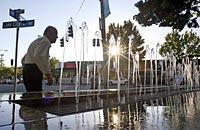Metamorphosis of Lake City

If you didn't know about the chocolates at Baker's Restaurant, you might drive right past the restaurant and chocolate shop — and even past all of Lake City.
But if you did, you'd miss the chance to walk into an old-fashioned diner — with the warm-chocolate smell if you timed it right.
Lake City is a car-oriented Seattle neighborhood with a strip of shops, auto-sales lots and other businesses on either side of Lake City Way Northeast.
The neighborhood has gone through ups and downs throughout its lifespan as Aurora Avenue North and then Interstate 5 siphoned off some of its drive-through business.
"Basically, what it boils down to is it's a huge transit place," Baker's Restaurant employee Hollis Smith said as she made a mocha for a customer waiting at the counter. Other customers read the newspaper and sipped coffee while they waited in booths for their breakfast.
Smith, who also runs the chocolate factory, said she sees a wide range of people as customers — some who have been coming for decades and others who are newer to Lake City. In recent years, Lake City has become more diverse.
"Families from many parts of the world have settled in Lake City and nearby neighborhoods," said Ed Pottharst, Lake City's neighborhood district coordinator. That is reflected in the restaurants in the neighborhood.
"There are Hispanic, Thai, Japanese, Chinese, Persian, Eritrean, Pakistani, Indian and other ethnic eateries in Lake City," Pottharst said.
Seattle is working on making Lake City into an urban-village hub that is more pedestrian-friendly and has more mixed-use housing and retail, Pottharst said. The city recently redeveloped a park next to the library.
Rod Jordan, who has lived in Lake City for nearly his entire life, said the park used to be a warehouse, two falling-down garages and a big hole.
Jordan and his two brothers and sisters have a business next door for building custom electrical controls for projects such as the bus tunnel and Safeco Field's lighting.
Jordan said Lake City used to have more of a sense of community. He remembers walking to a movie theater, A&W restaurant and bowling alley, none of which still exist.
But there are plenty of signs that the neighborhood is thriving, and what once was considered a north-end neighborhood is now considered close-in.
"Day by day, it becomes cleaner," Raza Bahrim, an employee at a Persian bakery called the Minoo Bakery, said of Lake City.
The median price of a home in the North Seattle area that includes Lake City increased 10.8 percent over the past year to $449,750, according to figures compiled by the Northwest Multiple Listing Service.

Lake City
![]()
![]()
Population: 17,005
Schools: Lake City is served by the Seattle school district.
Housing: Of 8,063 total housing units, 3,735 or 46.3 percent are owner-occupied, 3,933 or 48.8 percent are renter-occupied and 4.9 percent are vacant.
Nearby medical facilities: Northwest Hospital & Medical Center, 1550 N. 115th St.; Children's Hospital & Regional Medical Center, 4800 Sand Point Way N.E., University of Washington Medical Center, 1959 N.E. Pacific St.
Shopping: Lake City Farmers Market, Northeast 127th Street and 30th Avenue Northeast (behind the fire station); Thursdays, May 18 through Oct. 5, from 3 to 7 p.m.
Public facilities: Lake City Neighborhood Service Center, 12525 28th Ave. N.E. (second floor); Meadowbrook Community Center, 10517 35th Ave. N.E., facility rentals, playfield, playground, gymnasium;
Meadowbrook Pool, 10515 35th Ave. N.E.; Matthews Beach Park, 9300 51st Ave. N.E.
Seattle Times news researcher Miyoko Wolf